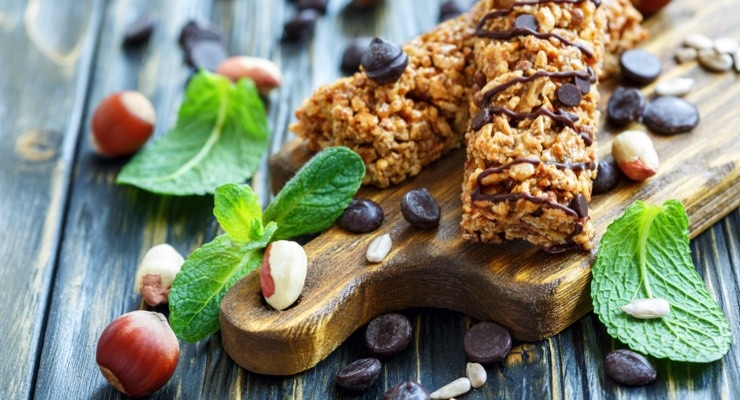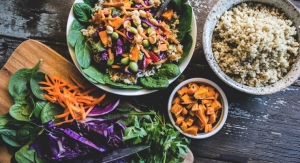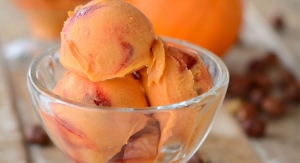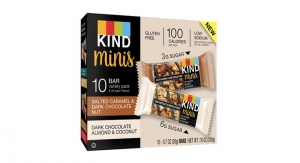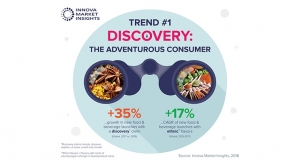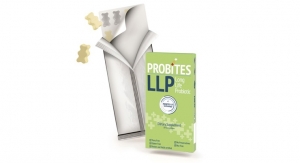By Sean Moloughney, Editor01.03.19
Looking for convenient, on-the-go nutrition or an indulgent treat—or sometimes both—consumers reach for snacks, on average, about 2.5 times a day, according to Information Resources Inc. (IRI), Chicago, IL. Overall, 49% of eating occasions involve snacks, according to the Hartman Group, Bellevue, WA; 8% of consumers forego meals altogether in favor of all-day snacking.
Trend Tracking
High protein, low carb, high fiber, and clean label are major, long-lasting trends in the bar and snacks market, according to Elizabeth Sloan, PhD, and Catherine Adams Hutt, PhD, RD, from Sloan Trends, Inc., Escondido, CA. Half (48%) of consumers buy nutrition bars for protein, Dr. Sloan noted, 26% weight loss, 20% athletic performance, 19% for super food ingredients, and 10% for a specific condition, according to Packaged Facts, Rockville, MD.
“Snacks that give consumers permission to enjoy their indulgent favorites, because they have less of an undesirable ingredient or an added benefit, posted the highest growth in 2017,” Dr. Adams Hutt added.
“Consumers between the ages of 18 and 54 are the heaviest users of nutritional shakes and bars, with use of these products decreasing among subsequent age groups,” Dr. Sloan said. “Young people are more likely to be busy and interested in convenient, on-the-go meal options and snacks, as well as being more open to trying new nutritional products than older consumers. Older consumers continue to represent a growth opportunity for bars, which is still virtually untapped.”
Two-thirds (65%) of adults look for foods/beverages that have added vitamins/minerals, according to the Hartman Group. Sixty-three percent are trying to add more fiber, 60% protein, 59% vitamin D, 58% whole grains, 57% nuts/seeds, 54% calcium, 51% olive oil, 43% antioxidants, 42% green tea or fish oil, 38% probiotics, and 32% plant-based protein.
“Snack marketers need to recognize that beverages are strong snack options,” Dr. Sloan said. “Nearly two-thirds of adults say they sometimes have a drink as a snack, per IRI. Non-dairy beverages and coffee/tea-based dairy drinks have been among the biggest gainers for snacking.”
Products that align with consumers’ lifestyles are a main driver in the wellness snacks market, according to IRI; 75% of consumers want snacks that are guaranteed fresh; 58% want snacks that contain vitamins and minerals; 57% want all-natural snacks or those made with natural ingredients; 44% want snacks made with whole grains.
Additionally, 50% of consumers say they will pay more for snacks that are healthier, according to IRI.
Organic and vegan products are driving growth as well, as consumers opt for gluten-free, non-GMO, high-protein, low-sugar options. IRI data also indicated strong growth in paleo-friendly, plant-based snacks, as product innovation is helping consumers reach and maintain their lifestyle goals.
For example, Better For You (BFY) Brands’ gluten-free, non-GMO Protein Crisps feature 10 grams of protein from soy and cassava, as well as 4 grams of fiber.
Coconut has also seen increased interest as an ingredient in snack products. Alter Eco’s Dark Chocolate Coconut Clusters combine ribbons of toasted, sustainably-harvested coconut with the company’s signature dark, 70% Ecuadorian chocolate and French sea salt. The products are vegan, paleo-friendly, certified-organic, Fair Trade Certified, Carbon Neutral Certified, Non-GMO Project Verified, and Certified Gluten-Free.
Probiotics continue to drive innovation as well, as 40% of consumers want snacks that have probiotics to help with digestion, according to IRI. A range of probiotic-containing products, including oatmeal, bars, smoothies, yogurts, and more—often combined with protein—has reached the mainstream.
Eggs are making a comeback as a protein source in a variety of formats, including bars. The popularity of RX Bars, which feature clean labels and simple ingredient lists on the front of packaging, have spurred a host of similarly formulated and positioned products.
In terms of product format, the variety of cookies on the market has broadened. For example, NuGo’s vegan, gluten-free, non-GMO Protein Cookie boasts 16 grams of protein and 12 grams of fiber with no dairy, soy, eggs, artificial sweeteners, or palm oil.
Raising the Bar
Snack bars have come a long way since the first granola bars were introduced back in the 1970s, and the market continues to diversify, with many fruit, nut, and sports protein bars now competing alongside traditional cereal bars. Health is still an overriding factor for innovators as snack bars position themselves as more nutritious alternatives to confectionery, biscuits, and cakes.
The global market for cereal and energy bars (excluding specialist sports nutrition products) reached nearly $13.7 billion at the retail level in 2017 and has been seeing very positive growth, with a CAGR of 4.3% registered over 2010-2022, according to Innova Market Insights. North America accounts for a dominant 61% of that, with the U.S. the largest individual market, ahead of the U.K. and Canada.
“It is clear that cereal bars continue to be popular, reflecting their significance as a convenient, portable snack or meal replacement with a nutritious image,” said Lu Ann Williams, director of innovation at Innova Market Insights. As its popularity has grown, the sub-category has broadened to encompass a wide range of products, including granola/muesli bars and breakfast bars, as well as nutrition, energy, and performance bars.
Health continues to be the most important issue affecting snack bar developments. There are now bars to suit all health needs, whether replacing high-calorie chocolate bars, achieving a specific hit of protein, or incorporating more super/whole foods into the diet.
According to Innova Market Insights research, the leading factor influencing purchasing decisions for snack bars was naturalness, cited by 35% of consumers across the 19 countries reviewed, with no artificial flavors/colors third at 20%. This reflects the ongoing interest in clean labeling, as does the overall use of clean label positionings of various kinds for more than half of global launches.
Sugar reduction is also very important, with no, low, or reduced sugar cited as the second most important factor affecting purchasing decisions. Mentioned by 23% of consumers globally, it was the number two factor in 12 of the 19 countries reviewed.
Free from claims are also very important, with gluten-free in particular widely targeted and labeled, although there is also ongoing interest in lactose-free and growing use of vegan-friendly certification.
In more developed markets, protein positionings for snack bars are now well established in the mainstream as well as in specialist sports nutrition, and ingredient choices are diversifying, with plant- or even insect-powered bars now available alongside those with dairy or soy proteins. Fiber, from whole grains or more specialist prebiotics, remains another important focus, while naturally healthy ingredients are also extremely popular, with super fruits, vegetables, seeds, nuts, and ancient grains all adding value, as well as buzzwords such as raw, simple, and paleo.
“While health and nutrition concerns appear to be driving product development, it must not be forgotten that taste, convenience, and novelty are also very important if the products are to compete successfully with other snacks and meal replacements,” said Ms. Williams. “Increasingly indulgent ingredient blends and flavors are also featuring strongly, including more savory options and sweet/savory combos, along with the development of new formats, such as mini and bite-size options in resealable pouches or sharing bags.”
Power of Protein
Convenience and availability are driving demand for healthy snacks and nutrition bars, according to Stephanie Lynch, vice president of sales, marketing, and technology, International Dehydrated Foods, Inc. (IDF), Springfield, MO. “With such a variety of options available, consumers can find a bar or other healthy snack that offers on-the-go convenience, the nutritional qualities they want, and a taste they prefer.”
Protein has become increasingly popular as more people are looking for ways to stay full, she added. “More than that, the protein market appeals to a broad range of consumers who seek it for a variety of other reasons, including sports recovery, weight management, and more.”
In fact, according to research by the Natural Marketing Institute (NMI), Harleysville, PA, nearly four out of five consumers consider protein content as an important factor in food and beverage purchasing decisions.
“We’re seeing that our customers want allergen-free ingredients to support healthy, protein-rich snacks and bars,” said Ms. Lynch. “Many protein products are made with soy or whey, which some consumers choose not to or can’t eat. Many people are allergic to these (and other) common sources of protein. Dairy, wheat, and soy are present on the list of eight major food allergens, and 63% of the human population has a reduced ability to digest lactose after infancy.”
Moreover, specialty diets such as keto, paleo, and gluten-free are trending, so an increasing number of people are cutting common sources of protein from their diets. Chicken offers a versatile and diet-friendly protein, Ms. Lynch said. “Additionally, about 77% of consumers already get their protein from chicken, according to the NPD Group, making it a familiar choice that supports a clean label.”
Moving forward, the meat snack category will continue to see impressive growth, according to Datamonitor. “However, consumers want something other than jerky-style meat snacks, and this desire has led to the introduction of meat bars,” said Ms. Lynch. “Meat bars are a convenient way to deliver protein and other nutritional benefits, and they align with the popular keto and paleo diets. Additionally, we believe the next big thing will be protein crisps and other snack formats for children. Fortified snacks could be a solution to help kids get enough protein and nutrition needed for development. While most parents strive to give their children balanced meals, when it comes to picky eaters, sometimes the only option is a snack to prevent an empty stomach. Understandably, discerning parents no longer want to dole out snacks with little to no nutritional value, and they would welcome a healthy option that allows children to enjoy their protein.”
Nearly 5,000 food and nutrition experts predicted 2019’s developing ingredients, flavors, and wellness practices.
KIND Healthy Snacks (KIND) has forecasted the top 10 food and nutrition trends for 2019. The report is a compilation of thinking from nearly 5,000 experts and practitioners within the food and beverage industry, such as KIND’s new product development team of chefs and food scientists, KIND’s Nutrition Collective network of 4,500+ registered dietitians, international team members across Europe, North America, and Asia-Pacific, and Daniel Lubetzky, KIND’s founder and CEO.
Seed Butters. It’s no surprise that 2018 was the year of alternative nut butters—such as almond butter, cashew butter, and walnut butter. While nut butters’ popularity likely won’t slow down in the coming year, KIND’s report anticipated a new offering to hit the scene: seed butters. In 2019, keep an eye out for sunflower, pumpkin, and watermelon seed butters, which share the same good fat profile of nut butters, but may offer an alternative for those with nut allergies.
Cannabinoid Craze. While CBD can be found within lotions and oils to help people with chronic conditions, 2019 marks the year where the cannabis plant extract makes its way into the food and beverage industries, the report predicted. CBD can already be found in coffee, cocktails, and olive oil. Experts anticipate CBD to permeate into other formats such as yogurts, soups, and salad dressings.
Food Porn No More. The business of perfect-looking food has been ubiquitous within society for the past few decades. In 2019, expect this movement to be flipped on its head, and “ugly” foods to earn the praise they’ve long deserved. To help prevent food waste, look for retail programs that encourage shoppers to buy ugly produce that is misshapen or flawed in some way.
African Flavors. African-inspired culinary influences have been ever-present in the American restaurant scene, but 2019 marks the year these spices and super foods will make their way into more conventional formats. Flavors and ingredients like harissa, berbere, dukkah, ras el hanout, and tiger nuts could make their way into U.S. pantries in items such as condiments, grain snacks, and protein rubs.
Trust Your Gut (Health). Digestive health has emerged as a core component of the modern view of health and wellness, with new appreciation for the impact of the microbiome. Look for even more products to tout the gut health trio of fiber, prebiotics, and probiotics. On food labels, look for a Daily Value of 10% or more to indicate the product contains a “good source” of fiber.
‘Anti-Sugar’ to ‘Anti-Added Sugar’. With the new requirement that companies distinguish between added and naturally-occurring sugars on food labels, consumers are becoming more aware that not all sugars are created equal. Added sugars are those not naturally found in foods or beverages and are added during manufacturing. Research has shown that dietary patterns lower in sugar-sweetened foods and beverages reduce the risk of cardiovascular disease—stressing the need for individuals to be mindful of their intake.
H2-Wh0a. While infusing water with fruits and vegetables is common for many Americans, other forms of hydration are expected to gain popularity. Coconut water will remain mainstream, but other options will be available for those looking to add more vitamins, minerals, and prebiotics to their diet. Such options will include maple water, which contains less than half the sugar of coconut water, as well as cactus water, which is promoted for skin revitalization.
Going Meatless Isn’t Just for Mondays. From plants to insects and lentils to soy, meat and dairy-free protein alternatives are becoming more mainstream. Experts anticipate seeing more innovations highlighting nuts, extruded seeds, beans, water lentils, and algae across categories such as snack bars, chips, meat-free burgers or sausages, and dairy-free yogurts and cheeses.
Foods First, Vitamins Second. With growing interest in clean labeling, individuals have adopted a “food-first” mindset and started embracing whole, minimally processed foods to meet their nutritional needs. This means they are moving away from heavily fortified products and replacing them with whole options that are inherently nutrient-rich.
Transparency 2.0. While transparency within the food industry is table stakes at this point, consumers are continuing to hold food companies accountable and expect specific information on-pack. This past year, transparency made its way onto the nutrition label, ingredient list, and even marketing claims. In 2019, transparency will shape companies’ cultures, hiring practices, and inclusion measures.
Trend Tracking
High protein, low carb, high fiber, and clean label are major, long-lasting trends in the bar and snacks market, according to Elizabeth Sloan, PhD, and Catherine Adams Hutt, PhD, RD, from Sloan Trends, Inc., Escondido, CA. Half (48%) of consumers buy nutrition bars for protein, Dr. Sloan noted, 26% weight loss, 20% athletic performance, 19% for super food ingredients, and 10% for a specific condition, according to Packaged Facts, Rockville, MD.
“Snacks that give consumers permission to enjoy their indulgent favorites, because they have less of an undesirable ingredient or an added benefit, posted the highest growth in 2017,” Dr. Adams Hutt added.
“Consumers between the ages of 18 and 54 are the heaviest users of nutritional shakes and bars, with use of these products decreasing among subsequent age groups,” Dr. Sloan said. “Young people are more likely to be busy and interested in convenient, on-the-go meal options and snacks, as well as being more open to trying new nutritional products than older consumers. Older consumers continue to represent a growth opportunity for bars, which is still virtually untapped.”
Two-thirds (65%) of adults look for foods/beverages that have added vitamins/minerals, according to the Hartman Group. Sixty-three percent are trying to add more fiber, 60% protein, 59% vitamin D, 58% whole grains, 57% nuts/seeds, 54% calcium, 51% olive oil, 43% antioxidants, 42% green tea or fish oil, 38% probiotics, and 32% plant-based protein.
“Snack marketers need to recognize that beverages are strong snack options,” Dr. Sloan said. “Nearly two-thirds of adults say they sometimes have a drink as a snack, per IRI. Non-dairy beverages and coffee/tea-based dairy drinks have been among the biggest gainers for snacking.”
Products that align with consumers’ lifestyles are a main driver in the wellness snacks market, according to IRI; 75% of consumers want snacks that are guaranteed fresh; 58% want snacks that contain vitamins and minerals; 57% want all-natural snacks or those made with natural ingredients; 44% want snacks made with whole grains.
Additionally, 50% of consumers say they will pay more for snacks that are healthier, according to IRI.
Organic and vegan products are driving growth as well, as consumers opt for gluten-free, non-GMO, high-protein, low-sugar options. IRI data also indicated strong growth in paleo-friendly, plant-based snacks, as product innovation is helping consumers reach and maintain their lifestyle goals.
For example, Better For You (BFY) Brands’ gluten-free, non-GMO Protein Crisps feature 10 grams of protein from soy and cassava, as well as 4 grams of fiber.
Coconut has also seen increased interest as an ingredient in snack products. Alter Eco’s Dark Chocolate Coconut Clusters combine ribbons of toasted, sustainably-harvested coconut with the company’s signature dark, 70% Ecuadorian chocolate and French sea salt. The products are vegan, paleo-friendly, certified-organic, Fair Trade Certified, Carbon Neutral Certified, Non-GMO Project Verified, and Certified Gluten-Free.
Probiotics continue to drive innovation as well, as 40% of consumers want snacks that have probiotics to help with digestion, according to IRI. A range of probiotic-containing products, including oatmeal, bars, smoothies, yogurts, and more—often combined with protein—has reached the mainstream.
Eggs are making a comeback as a protein source in a variety of formats, including bars. The popularity of RX Bars, which feature clean labels and simple ingredient lists on the front of packaging, have spurred a host of similarly formulated and positioned products.
In terms of product format, the variety of cookies on the market has broadened. For example, NuGo’s vegan, gluten-free, non-GMO Protein Cookie boasts 16 grams of protein and 12 grams of fiber with no dairy, soy, eggs, artificial sweeteners, or palm oil.
Raising the Bar
Snack bars have come a long way since the first granola bars were introduced back in the 1970s, and the market continues to diversify, with many fruit, nut, and sports protein bars now competing alongside traditional cereal bars. Health is still an overriding factor for innovators as snack bars position themselves as more nutritious alternatives to confectionery, biscuits, and cakes.
The global market for cereal and energy bars (excluding specialist sports nutrition products) reached nearly $13.7 billion at the retail level in 2017 and has been seeing very positive growth, with a CAGR of 4.3% registered over 2010-2022, according to Innova Market Insights. North America accounts for a dominant 61% of that, with the U.S. the largest individual market, ahead of the U.K. and Canada.
“It is clear that cereal bars continue to be popular, reflecting their significance as a convenient, portable snack or meal replacement with a nutritious image,” said Lu Ann Williams, director of innovation at Innova Market Insights. As its popularity has grown, the sub-category has broadened to encompass a wide range of products, including granola/muesli bars and breakfast bars, as well as nutrition, energy, and performance bars.
Health continues to be the most important issue affecting snack bar developments. There are now bars to suit all health needs, whether replacing high-calorie chocolate bars, achieving a specific hit of protein, or incorporating more super/whole foods into the diet.
According to Innova Market Insights research, the leading factor influencing purchasing decisions for snack bars was naturalness, cited by 35% of consumers across the 19 countries reviewed, with no artificial flavors/colors third at 20%. This reflects the ongoing interest in clean labeling, as does the overall use of clean label positionings of various kinds for more than half of global launches.
Sugar reduction is also very important, with no, low, or reduced sugar cited as the second most important factor affecting purchasing decisions. Mentioned by 23% of consumers globally, it was the number two factor in 12 of the 19 countries reviewed.
Free from claims are also very important, with gluten-free in particular widely targeted and labeled, although there is also ongoing interest in lactose-free and growing use of vegan-friendly certification.
In more developed markets, protein positionings for snack bars are now well established in the mainstream as well as in specialist sports nutrition, and ingredient choices are diversifying, with plant- or even insect-powered bars now available alongside those with dairy or soy proteins. Fiber, from whole grains or more specialist prebiotics, remains another important focus, while naturally healthy ingredients are also extremely popular, with super fruits, vegetables, seeds, nuts, and ancient grains all adding value, as well as buzzwords such as raw, simple, and paleo.
“While health and nutrition concerns appear to be driving product development, it must not be forgotten that taste, convenience, and novelty are also very important if the products are to compete successfully with other snacks and meal replacements,” said Ms. Williams. “Increasingly indulgent ingredient blends and flavors are also featuring strongly, including more savory options and sweet/savory combos, along with the development of new formats, such as mini and bite-size options in resealable pouches or sharing bags.”
Power of Protein
Convenience and availability are driving demand for healthy snacks and nutrition bars, according to Stephanie Lynch, vice president of sales, marketing, and technology, International Dehydrated Foods, Inc. (IDF), Springfield, MO. “With such a variety of options available, consumers can find a bar or other healthy snack that offers on-the-go convenience, the nutritional qualities they want, and a taste they prefer.”
Protein has become increasingly popular as more people are looking for ways to stay full, she added. “More than that, the protein market appeals to a broad range of consumers who seek it for a variety of other reasons, including sports recovery, weight management, and more.”
In fact, according to research by the Natural Marketing Institute (NMI), Harleysville, PA, nearly four out of five consumers consider protein content as an important factor in food and beverage purchasing decisions.
“We’re seeing that our customers want allergen-free ingredients to support healthy, protein-rich snacks and bars,” said Ms. Lynch. “Many protein products are made with soy or whey, which some consumers choose not to or can’t eat. Many people are allergic to these (and other) common sources of protein. Dairy, wheat, and soy are present on the list of eight major food allergens, and 63% of the human population has a reduced ability to digest lactose after infancy.”
Moreover, specialty diets such as keto, paleo, and gluten-free are trending, so an increasing number of people are cutting common sources of protein from their diets. Chicken offers a versatile and diet-friendly protein, Ms. Lynch said. “Additionally, about 77% of consumers already get their protein from chicken, according to the NPD Group, making it a familiar choice that supports a clean label.”
Moving forward, the meat snack category will continue to see impressive growth, according to Datamonitor. “However, consumers want something other than jerky-style meat snacks, and this desire has led to the introduction of meat bars,” said Ms. Lynch. “Meat bars are a convenient way to deliver protein and other nutritional benefits, and they align with the popular keto and paleo diets. Additionally, we believe the next big thing will be protein crisps and other snack formats for children. Fortified snacks could be a solution to help kids get enough protein and nutrition needed for development. While most parents strive to give their children balanced meals, when it comes to picky eaters, sometimes the only option is a snack to prevent an empty stomach. Understandably, discerning parents no longer want to dole out snacks with little to no nutritional value, and they would welcome a healthy option that allows children to enjoy their protein.”
Nearly 5,000 food and nutrition experts predicted 2019’s developing ingredients, flavors, and wellness practices.
KIND Healthy Snacks (KIND) has forecasted the top 10 food and nutrition trends for 2019. The report is a compilation of thinking from nearly 5,000 experts and practitioners within the food and beverage industry, such as KIND’s new product development team of chefs and food scientists, KIND’s Nutrition Collective network of 4,500+ registered dietitians, international team members across Europe, North America, and Asia-Pacific, and Daniel Lubetzky, KIND’s founder and CEO.
Seed Butters. It’s no surprise that 2018 was the year of alternative nut butters—such as almond butter, cashew butter, and walnut butter. While nut butters’ popularity likely won’t slow down in the coming year, KIND’s report anticipated a new offering to hit the scene: seed butters. In 2019, keep an eye out for sunflower, pumpkin, and watermelon seed butters, which share the same good fat profile of nut butters, but may offer an alternative for those with nut allergies.
Cannabinoid Craze. While CBD can be found within lotions and oils to help people with chronic conditions, 2019 marks the year where the cannabis plant extract makes its way into the food and beverage industries, the report predicted. CBD can already be found in coffee, cocktails, and olive oil. Experts anticipate CBD to permeate into other formats such as yogurts, soups, and salad dressings.
Food Porn No More. The business of perfect-looking food has been ubiquitous within society for the past few decades. In 2019, expect this movement to be flipped on its head, and “ugly” foods to earn the praise they’ve long deserved. To help prevent food waste, look for retail programs that encourage shoppers to buy ugly produce that is misshapen or flawed in some way.
African Flavors. African-inspired culinary influences have been ever-present in the American restaurant scene, but 2019 marks the year these spices and super foods will make their way into more conventional formats. Flavors and ingredients like harissa, berbere, dukkah, ras el hanout, and tiger nuts could make their way into U.S. pantries in items such as condiments, grain snacks, and protein rubs.
Trust Your Gut (Health). Digestive health has emerged as a core component of the modern view of health and wellness, with new appreciation for the impact of the microbiome. Look for even more products to tout the gut health trio of fiber, prebiotics, and probiotics. On food labels, look for a Daily Value of 10% or more to indicate the product contains a “good source” of fiber.
‘Anti-Sugar’ to ‘Anti-Added Sugar’. With the new requirement that companies distinguish between added and naturally-occurring sugars on food labels, consumers are becoming more aware that not all sugars are created equal. Added sugars are those not naturally found in foods or beverages and are added during manufacturing. Research has shown that dietary patterns lower in sugar-sweetened foods and beverages reduce the risk of cardiovascular disease—stressing the need for individuals to be mindful of their intake.
H2-Wh0a. While infusing water with fruits and vegetables is common for many Americans, other forms of hydration are expected to gain popularity. Coconut water will remain mainstream, but other options will be available for those looking to add more vitamins, minerals, and prebiotics to their diet. Such options will include maple water, which contains less than half the sugar of coconut water, as well as cactus water, which is promoted for skin revitalization.
Going Meatless Isn’t Just for Mondays. From plants to insects and lentils to soy, meat and dairy-free protein alternatives are becoming more mainstream. Experts anticipate seeing more innovations highlighting nuts, extruded seeds, beans, water lentils, and algae across categories such as snack bars, chips, meat-free burgers or sausages, and dairy-free yogurts and cheeses.
Foods First, Vitamins Second. With growing interest in clean labeling, individuals have adopted a “food-first” mindset and started embracing whole, minimally processed foods to meet their nutritional needs. This means they are moving away from heavily fortified products and replacing them with whole options that are inherently nutrient-rich.
Transparency 2.0. While transparency within the food industry is table stakes at this point, consumers are continuing to hold food companies accountable and expect specific information on-pack. This past year, transparency made its way onto the nutrition label, ingredient list, and even marketing claims. In 2019, transparency will shape companies’ cultures, hiring practices, and inclusion measures.

